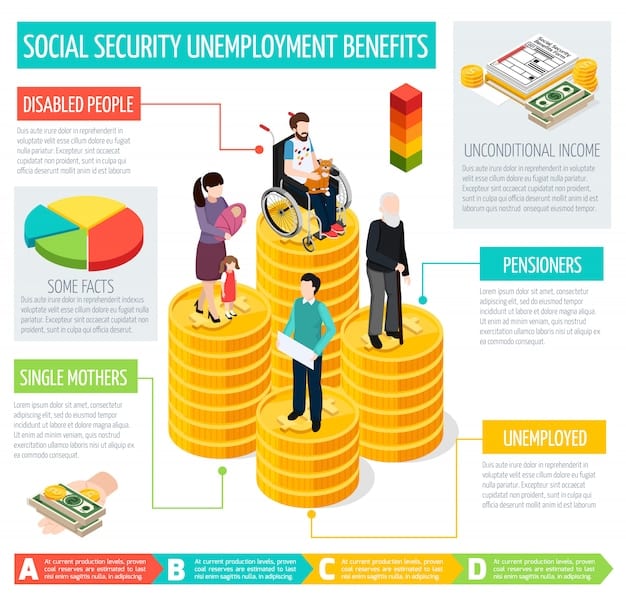Maximize Your Benefits: Understanding Social Security Spousal Benefits

Social Security spousal benefits allow individuals to claim up to 50% of their spouse’s Social Security amount, providing crucial financial support to eligible individuals, especially those with lower personal earnings or who have devoted their lives to caregiving.
Are you aware that you might be entitled to **Social Security spousal benefits**, potentially receiving up to 50% of your partner’s Social Security amount? These benefits are crucial for many, providing a financial safety net, especially if you have lower individual earnings or spent significant time as a caregiver. Let’s explore the eligibility, calculations, and strategies to maximize these benefits.
Understanding Social Security Spousal Benefits
Social Security isn’t just for those who have worked and paid into the system themselves. It also recognizes the contributions of spouses, particularly those who may have had lower earnings or focused on family care. Spousal benefits are designed to provide financial help to eligible individuals based on their spouse’s earnings record.
Who is Eligible for Spousal Benefits?
To qualify for spousal benefits, several criteria must be met. Understanding these requirements is the first step in determining your eligibility.
- You must be at least 62 years old, unless caring for a child under age 16 or disabled.
- Your spouse must be receiving Social Security retirement or disability benefits.
- You must be married to the individual.
- The benefit you could receive based on your own work history must be less than what you would receive based on your spouse’s record.
Divorced Spouses and Benefits
Even if you’re divorced, you may still be eligible for spousal benefits based on your ex-spouse’s record, provided you meet certain conditions:
- Your marriage lasted 10 years or longer.
- You are not currently married.
- Your ex-spouse is eligible for Social Security benefits, even if they are not currently receiving them.
- The benefit you could receive based on your own work history must be less than what you would receive based on your ex-spouse’s record.
In summary, Social Security spousal benefits are designed to support those who may not have substantial individual earnings but are married to someone who does. Understanding eligibility is essential to accessing these important benefits.
How Spousal Benefits Are Calculated
Calculating spousal benefits involves several factors, with the maximum benefit capped at 50% of the worker’s primary insurance amount (PIA). However, this is subject to reductions based on the age at which the spouse claims the benefit.

The 50% Rule
The maximum spousal benefit is 50% of the worker’s PIA. The PIA is the benefit a worker would receive if they retire at their full retirement age (FRA).
For example, if the worker’s PIA is $2,000, the maximum spousal benefit would be $1,000. However, if the spouse claims benefits before their FRA, this amount will be reduced.
Early Retirement Reductions
If you claim spousal benefits before your full retirement age, the benefit amount is reduced. The earlier you claim, the greater the reduction. This reduction is permanent.
For example, claiming at age 62, the earliest possible age, can reduce the spousal benefit to as little as 32.5% of the worker’s PIA.
Impact of Your Own Earnings
It’s important to note that if you are eligible for Social Security benefits based on your own work record, you will receive that amount first. If your spousal benefit is higher, you’ll receive the difference.
For instance, if your own benefit is $800 and your spousal benefit is $1,000, you will receive your $800 plus $200 from the spousal benefit for a total of $1,000.
In short, several factors affect the calculation of spousal benefits, including the worker’s PIA, the spouse’s age at claiming, and any benefits the spouse is entitled to based on their own work history. Understanding these details can help in making informed decisions.
Strategies to Maximize Spousal Benefits
Maximizing spousal benefits requires careful planning and understanding of the rules. Several strategies can help you secure the highest possible benefit amount.
Delay Claiming Benefits
One of the most effective strategies is to delay claiming spousal benefits until your full retirement age. By waiting, you avoid the reduction that comes with claiming early.
- Assess your financial needs and consider whether you can afford to wait.
- Consult with a financial advisor to understand the long-term implications.
- If possible, use other savings or income sources to bridge the gap until you reach your FRA.
Coordinating with Your Spouse
Coordinate your claiming strategy with your spouse to ensure the best possible outcome for both of you. This can be particularly important if one of you has a significantly higher PIA.
- Discuss your plans and financial needs with your spouse.
- Consider how your claiming decisions will affect each other’s benefits.
- Explore options like the file and suspend strategy (though no longer available, understand its history).
Understanding File and Suspend (Historical Context)
Previously, the file and suspend strategy allowed a worker to suspend their benefits while their spouse claimed spousal benefits. Although this strategy is no longer available, understanding how it worked can provide insights into planning.
In conclusion, maximizing spousal benefits involves strategic planning, and coordinating with your spouse, and understanding the impact of claiming age are critical to ensuring you receive the highest possible benefit.

The Impact of Filing Age on Spousal Benefits
The age at which you choose to file for spousal benefits has a significant and lasting impact on the amount you receive. Claiming earlier than your full retirement age results in a permanent reduction of benefits.
Claiming at Full Retirement Age (FRA)
If you wait until your full retirement age to claim spousal benefits, you will receive the maximum benefit amount, which is 50% of your spouse’s PIA. This is the most advantageous approach if you can afford to wait.
Claiming Before FRA
Claiming before FRA results in a reduced benefit. The reduction is calculated based on the number of months before your FRA that you claim. Each month results in a fraction of a percentage reduction.
For example, if your FRA is 67 and you claim at 62, your benefit could be reduced to around 32.5% of your spouse’s PIA.
Claiming After FRA
Unlike retirement benefits based on your own earnings record, spousal benefits do not increase if you delay claiming past your full retirement age. The maximum benefit remains at 50% of the worker’s PIA.
In summary, considering your filing age on spousal benefits is critical. Claiming at your full retirement age ensures you receive the maximum benefit amount, while claiming earlier results in a permanent reduction, making careful planning essential.
Common Misconceptions About Spousal Benefits
Several misconceptions exist regarding Social Security spousal benefits. Clarifying these misconceptions can help individuals make informed decisions and avoid costly mistakes.
Myth: I Automatically Get Half of My Spouse’s Benefit
While the maximum spousal benefit is 50% of the worker’s PIA, this isn’t automatic. The actual amount depends on various factors, including your age at claiming and your own earnings record.
Instead, you should verify what your spouse’s PIA is and see your expected benefit before making any decisions.
Myth: I Can Claim Spousal Benefits While My Spouse Delays
Generally, you cannot claim spousal benefits unless your spouse is already receiving retirement or disability benefits. There are exceptions, such as for divorced spouses under certain conditions.
- Ensure your spouse has filed for their own benefits.
- Examine if divorced spousal benefits are an option via your ex-spouse.
- Otherwise, you cannot successfully claim benefits on their record.
Myth: Spousal Benefits Reduce My Spouse’s Benefit
Claiming spousal benefits does not reduce the amount your spouse receives. Spousal benefits are paid based on your spouse’s record, but they do not affect the amount your spouse is entitled to.
In essence, it’s important to debunk common misconceptions surrounding Social Security spousal benefits to ensure individuals have accurate information for planning and decision-making.
Real-Life Examples of Spousal Benefits
Understanding how spousal benefits work in practice can be helpful. Let’s look at a few real-life examples to illustrate different scenarios and outcomes.
Example 1: Sarah and John
Sarah is 66 and John is 68. John receives a Social Security benefit of $2,400 per month. Sarah, who always worked part-time, is eligible for a benefit of $700 based on her own record. As a spousal benefit, she would be entitled to up to $1,200 (50% of John’s benefit). However, she will receive her own $700 plus $500 from the spousal benefit, totaling $1,200.
Example 2: Emily and David
Emily is 62 and David is 65. David receives $2,000 per month. Emily claims spousal benefits at age 62, which reduces her benefit. Instead of receiving $1,000 (50% of David’s benefit), she receives approximately $650 due to the early claiming reduction.
Example 3: Lisa and Mark (Divorced)
Lisa and Mark were married for 15 years and divorced. Mark is now receiving Social Security benefits. Lisa, who is unmarried, is eligible for spousal benefits based on Mark’s record. She receives 50% of Mark’s PIA because she is at her full retirement age and meets all other eligibility requirements.
In conclusion, these real-life examples demonstrate how Social Security spousal benefits can provide substantial financial support, illustrating the importance of understanding eligibility criteria, claiming age, and individual circumstances.
| Key Point | Brief Description |
|---|---|
| 👵 Eligibility ✅ | Must be 62+, with spouse receiving benefits; divorcees may also qualify. |
| 💰 Calculation ➗ | Up to 50% of spouse’s PIA; reduced if claimed before Full Retirement Age (FRA). |
| 🗓️ Filing Age ⏳ | FRA ensures maximum benefits; early claiming causes permanent reductions. |
| 💡 Maximizing 📈 | Delay claiming if possible; coordinate with spouse for optimal strategy. |
Frequently Asked Questions (FAQ)
▼
Yes, you may be eligible if you were married for at least 10 years, are currently unmarried, and your ex-spouse is entitled to Social Security benefits. Your own benefit must also be lower.
▼
No, claiming spousal benefits does not reduce the amount your spouse receives in retirement benefits. Spousal benefits are calculated based on your spouse’s record, but don’t affect their payout.
▼
The maximum spousal benefit is 50% of your spouse’s Primary Insurance Amount (PIA). This amount may be reduced depending on when you elect to start receiving the benefits.
▼
You can delay claiming spousal benefits, however, unlike your own retirement benefits, spousal benefits do not increase if claimed after your full retirement age (FRA). Claim at FRA for maximum benefit.
▼
If you’re eligible for both, you’ll generally receive the higher of the two amounts. Social Security will first pay your retirement benefit; if your potential spousal benefit is higher, you’ll receive the difference.
Conclusion
Understanding the nuances of **Social Security spousal benefits** can significantly impact your retirement income. By knowing the eligibility requirements, calculation methods, and strategies to maximize these benefits, you can better plan for your financial future, ensuring a more secure and comfortable retirement. Consider consulting with a financial advisor to tailor a claiming strategy that aligns with your unique circumstances.





